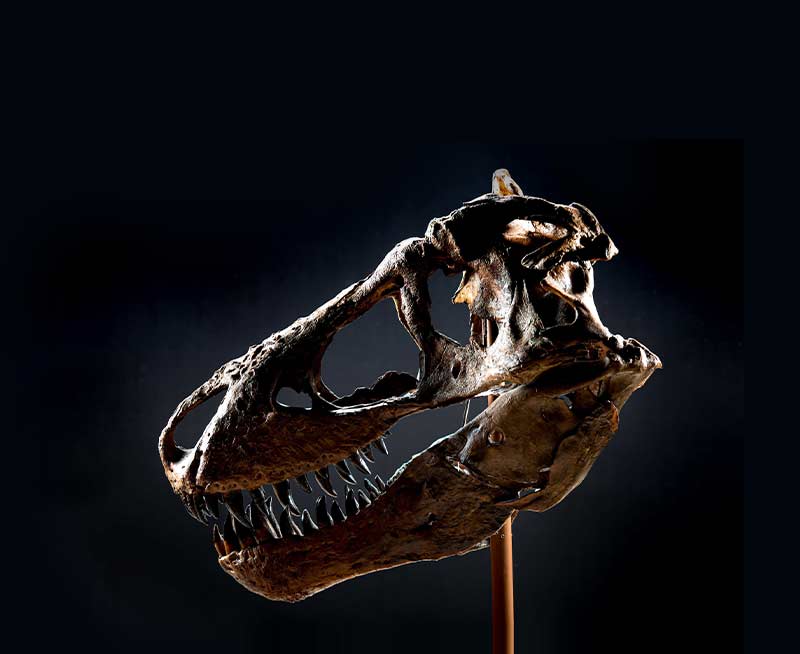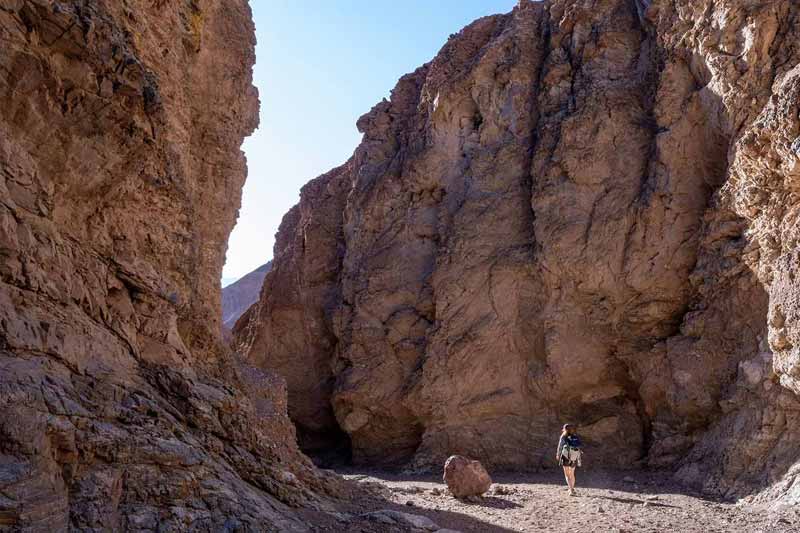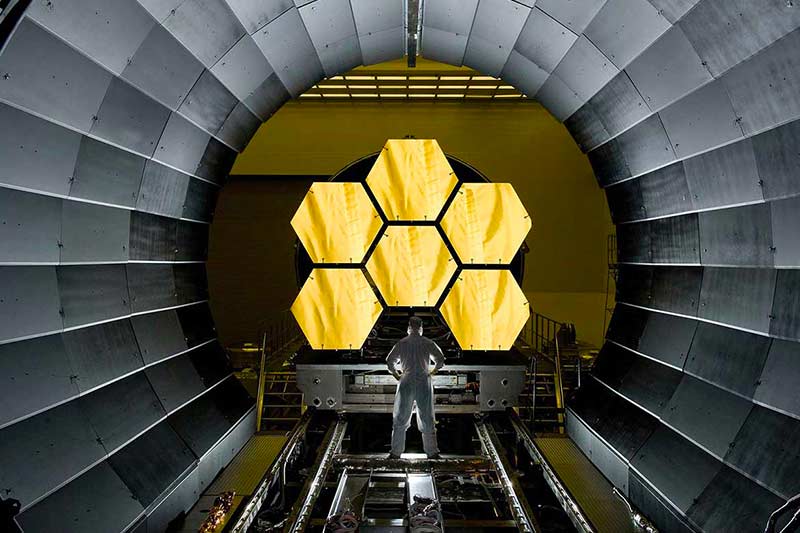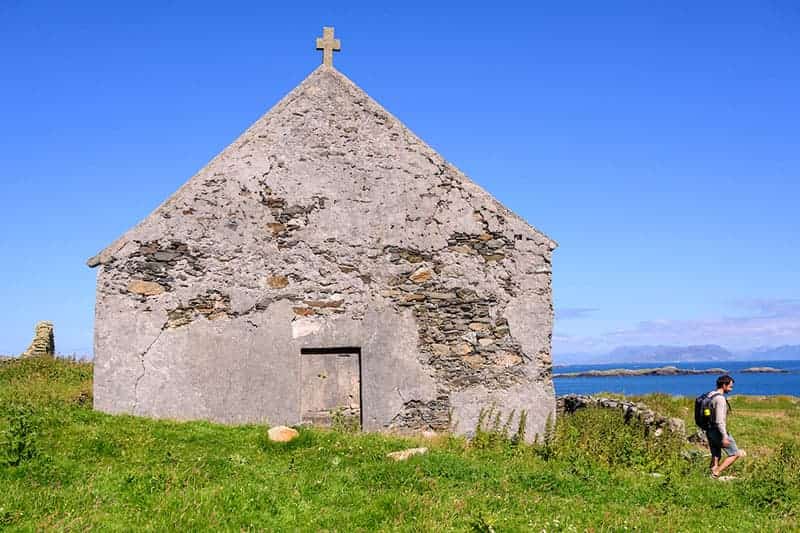A Notre Dame paleontologist, one of the world’s largest T. rex specimens and a tense standoff in the badlands of Montana
FORT PECK, Montana — The wind whispers on this morning in early June, and birds sing a short song every once in a while. Otherwise, silence reigns, with the only sign of human activity on this isolated spot in northeast Montana a distant two-lane road with an occasional car or truck. There are other signs of life, though — a deer had shed its antlers nearby, and a single primrose somehow sprouted out of dry, hard clay.
They call this Big Sky Country. Indeed, it is, and perhaps no more so than here in this stark and barren quadrant of the state. Today, the blue sky with big, puffy, white clouds stretches to the horizon and seemingly beyond.
And the land is just as big, and rugged, and imposing — and beautiful. Now arid, it was a swampland some 65 million years ago and more when dinosaurs roamed, swam and soared in these parts, including most notably the Tyrannosaurus rex — the “tyrant lizard king” — a bipedal carnivore with a massive skull that was balanced by a long, heavy tail. This is also where the dinosaurs died after an asteroid impact created so much atmospheric dust that sunlight was blocked, temperatures fell and the food supplies of many creatures on Earth, including the dinosaurs, were eliminated — or, that’s one theory. Many definitely died here, but not necessarily on the day the asteroid struck planet Earth. But more on that in a moment.
This site of whispering wind and songbirds is near the little town of Fort Peck — population 239 — which is about 75 miles south of the Canadian border and home to the massive Fort Peck Dam. The Kansas trading firm Durfee and Peck established a fort in the area in 1867 that served for about 15 years as a trading post and contained housing, a corral, stable, blacksmith shop, slaughterhouse, storehouses and a stockade. Though never an official military station, it often served as temporary headquarters for soldiers and commissioners who negotiated with local Native Americans before the Battle of Little Bighorn. Even earlier, Lewis and Clark came through the area in May 1805.
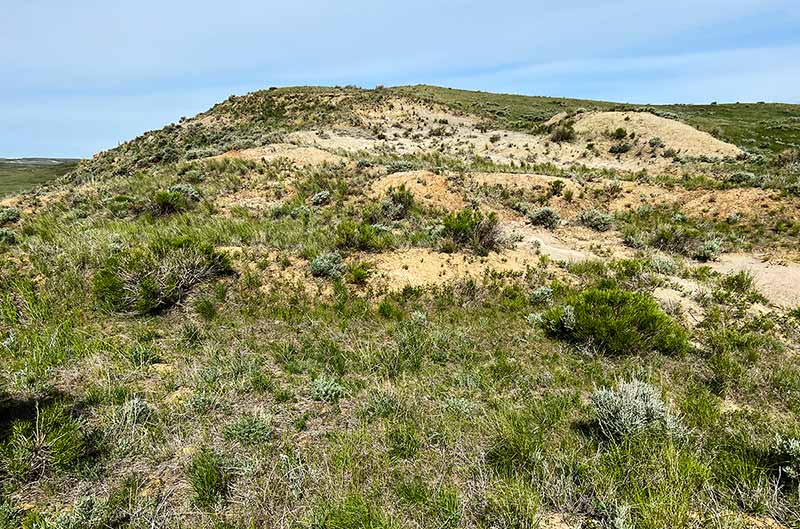
The current town of Fort Peck was founded in 1934 a few miles north of the old fort after the Army Corps of Engineers began construction on an earthen dam that was a project of the New Deal’s Public Works Administration. The town included an administrative headquarters, hospital, stores, a theater, recreation hall and other facilities. The housing in Fort Peck was insufficient for the more than 10,000 workers assigned to the dam, which led to the creation of other small towns in the area.
The dam stands on a stretch of the Missouri River and, at 21,026 feet in length and more than 250 feet in height, it is the largest hydraulically filled dam in the world. The project was featured on the cover of the first issue of Life magazine on Nov. 23, 1936, and since its completion has provided massive amounts of hydroelectric power as well as flood control and water quality management. It also created Fort Peck Lake, the fifth-largest artificial lake in the country at more than 130 miles long and 200 feet deep. Its 1,520-mile shoreline is longer than California’s coastline, all of which make the lake and little town a popular recreation area for boating, swimming and fishing.
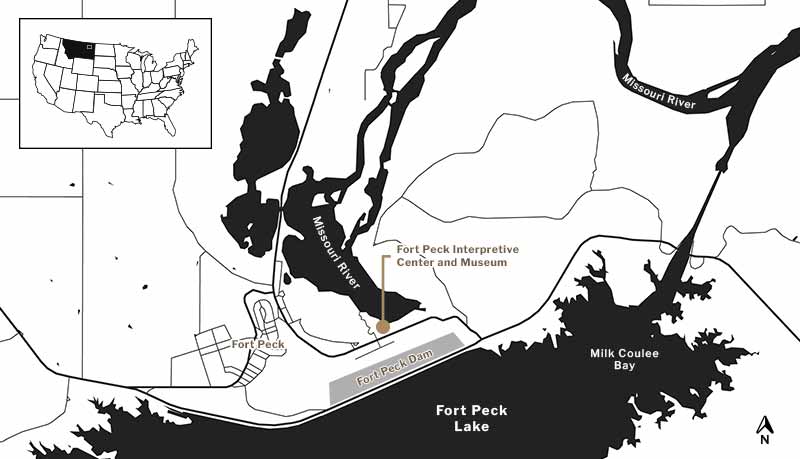
But it was the area’s previous life as home to dinosaurs that drew University of Notre Dame geology professor and paleontologist J. Keith Rigby to Fort Peck year after year in the 1980s and ’90s, until 25 years ago, on July 4, 1997, his team of mostly volunteers uncovered one of the largest fossilized T. rex skeletons ever found. It was a discovery that led to a remarkable series of events that included disputed land claims, poachers, threats of violence, drawn guns, damaged bones and, in the end, an assembled T. rex skeleton that, in addition to its size, is among the world’s most complete.
Keith Rigby Jr. was born Oct. 10, 1947, in Salt Lake City to J. Keith Rigby Sr. and Ruth Marie Krebs Rigby. Junior followed his father in more than just name. The elder Rigby earned his doctoral degree from Columbia University and spent his career as a geology professor at Brigham Young University. His son was likewise attracted to the study of geology and at age 14 worked as a geological field assistant in the western U.S. and in Canada. He went on to earn his bachelor’s degree at BYU and a doctorate in geology from Columbia, specializing in the mammalian fossil record. He took a break from his undergraduate studies to serve for two years as a Church of Jesus Christ of Latter-day Saints missionary in Austria.
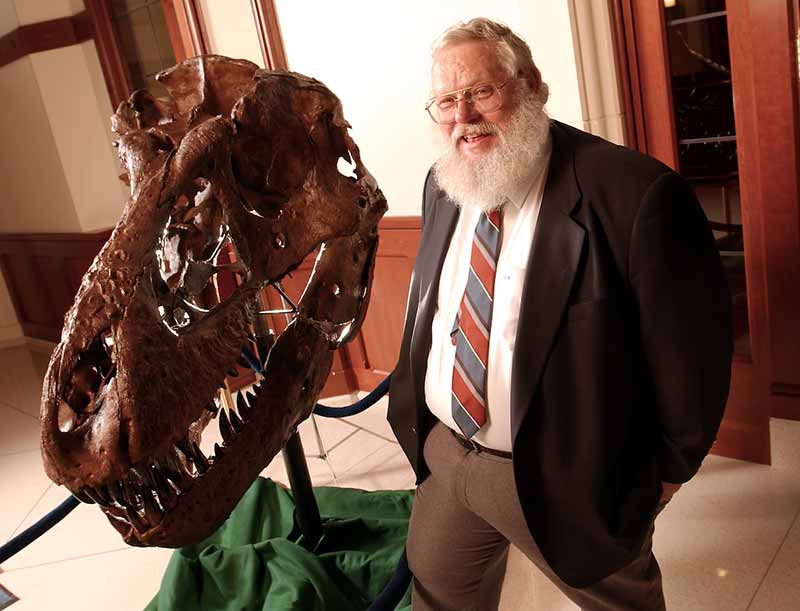
After receiving his doctoral degree in 1976, the younger Rigby worked for six years as a district paleontologist for the U.S. Bureau of Land Management, and then secured a faculty appointment at Notre Dame in 1982 as an assistant professor of earth sciences, now part of the Department of Civil and Environmental Engineering and Earth Sciences.
It wouldn’t take long for him to rock — as it were — the paleontological boat.
The journal Science, a weekly publication of the American Association for the Advancement of Science, published peer-reviewed research by Rigby in May 1985 that supported a theory that dinosaur extinction occurred gradually over millions of years, not all at once after an asteroid struck our planet just off the Yucatan Peninsula. His examination of fossils in the Hell Creek Formation along the Fort Peck reservoir found that the dinosaurs started to die off about 72 million years ago, some seven million years before the asteroid event.
Dozens of media outlets reported on the “gradualist theory” advanced by Rigby and partners from the University of Minnesota, University of Chicago and Milwaukee Public Museum. In addition to finding that dinosaurs began to succumb before the asteroid, they also found geological evidence that many survived the impact and lived for several thousands of years after. They presented further evidence in published research on the extinction of dinosaurs in 1989 and again in 1993.
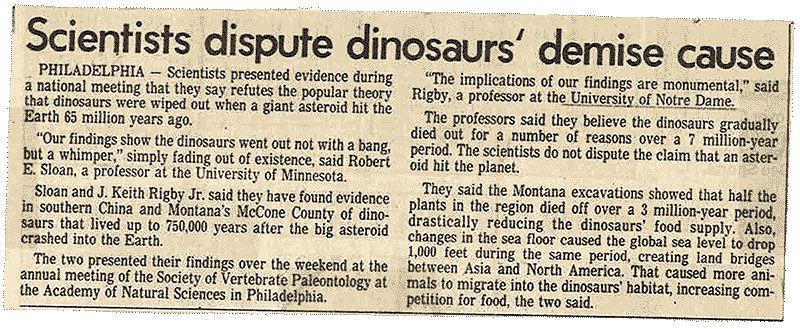
“If we say the (asteroid) event occurred 65 million years ago, these fossils (found in Hell Creek) are obviously younger than the impact,” Rigby said in a 1985 Notre Dame news release. “There are some species of dinosaurs that became extinct before others, but based upon the materials we have found, we believe that 70 percent of the kinds of dinosaurs living at that time survived the asteroid impact. The biological consequences (were) not as great as some people would have us believe. There was an event and the subsequent climate change probably caused the death of a large number of organisms, but not the extinction of dinosaurs.”
Not surprisingly, the findings by Rigby and his associates were debunked at conferences and in the media by strict adherents to the asteroid theory. One scientist compared their theory to the widely — and legitimately — criticized “cold fusion” research. However, others supported the gradualists, positing that volcanic eruptions and other naturally occurring events, including the asteroid, led to the extinction of dinosaurs.
Despite Rigby’s evidence, the asteroid impact remains the dominant theory. This past May, for example, the Washington Post published an extinction story with a headline reading “Discoveries shed new light on the day the dinosaurs died.”
While Rigby’s differing view on the asteroid theory drew widespread media attention, there would be even more several years later for other reasons.
During his excursions to northeastern Montana, Rigby was often joined by Notre Dame students and adult volunteers, usually under the auspices of Earthwatch, a group based in Watertown, Massachusetts, that matches amateur scientists with projects conducted by researchers in a variety of fields including paleontology who need both financing and labor.
Rigby had received support from Earthwatch since 1988, with some 420 volunteers having joined him in the desert badlands near Fort Peck. After finding a large area with the bones of a hadrosaur in the summer of 1996, Rigby and his team returned a year later to dig deeper. (In the interest of safety, security and science, the U.S. Army Corps of Engineers, which now manages the area, asked that the exact location of Rigby’s fieldwork be kept confidential.)
Among the volunteer team members was Louis Tremblay, a 56-year-old earth sciences teacher at Avon High School near Hartford, Connecticut, who had volunteered with Rigby since 1991. Tremblay was enrolled in an advanced degree program at Southern Connecticut State University, which required working on a field project or in a lab to gain hands-on experience to enhance the teaching of high school science.
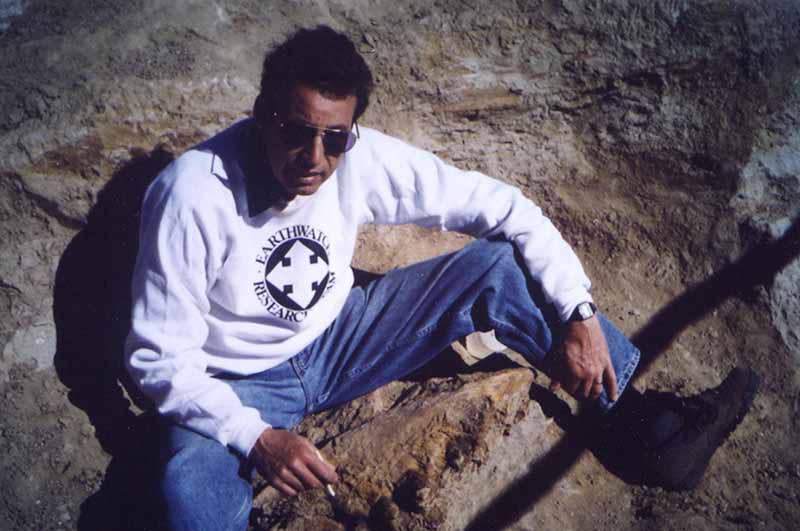
“I was an earth science teacher, and so I had a background in geology and the Earth’s history,” Tremblay said in a phone interview earlier this year. “At that time, there was a lot of interest in the various theories about what caused the dinosaurs to become extinct, and that was one of the things that Dr. Rigby was working on. He sent a letter inviting me and other past participants to join him (in the summer of 1997). That’s how the group of us ended up being there.”
“Dr. Rigby had taught me back in 1991 how to find dinosaur bones, (but) I had no idea what it was. I was just fortunate that I happened to be the one to come across it.”—Lou Tremblay
While some team members excavated the hadrosaur, Rigby asked Tremblay and several others to hunt on a nearby hillside near where that single primrose and deer antlers were spotted in early June. It was July 4, and, after initially seeing a few bone chips, Tremblay remembers, “I found a bone that was actually protruding from the ground. I brushed away some of the soil from it, and that turned out to be the first bone that was actually part of Peck’s Rex. The bone itself, I believe, was later identified to be one of the stomach ribs.”
Despite his previous experience, Tremblay said he didn’t know at the time exactly what he had come upon. He took a picture of the protruding bone and showed it to Rigby.
“I was pretty excited,” he said. “Dr. Rigby had taught me back in 1991 how to find dinosaur bones, (but) I had no idea what it was. I was just fortunate that I happened to be the one to come across it.”
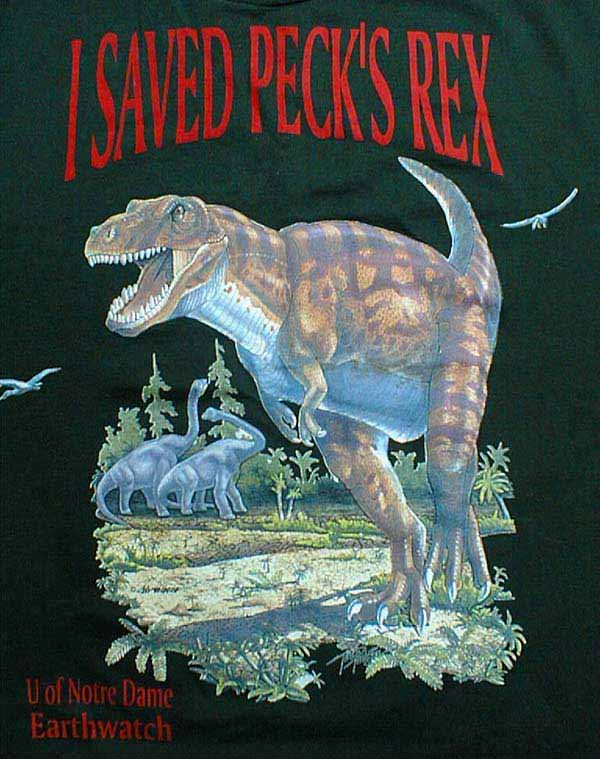
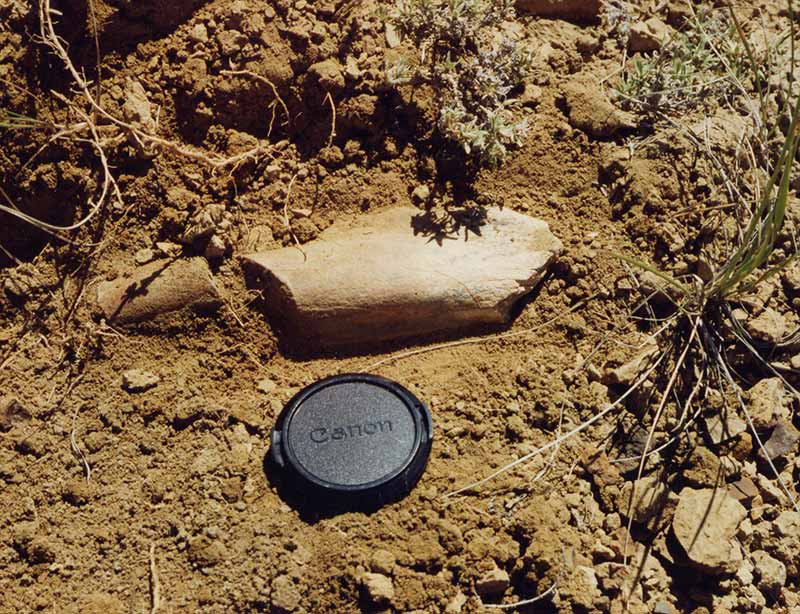
After Tremblay’s time that summer in Montana ended, other volunteers joined Rigby for the rest of July and into August, finding more bones — including the skull — and realizing that Lou Tremblay’s fortunate find on the Fourth of July was, in fact, a major discovery. When it came time for Rigby to return for the fall semester at Notre Dame, he closed up the site for the long winter by putting protective plaster jackets around the exposed bones, reburying them and back-filling the dig. His plan was to return the following summer to complete the excavation.
A part of the plan was hiring members of the Walton family, described in one media account as down-on-their-luck ranchers in the area and people Rigby had known for years, to keep an eye out for anyone who might try to tamper with the site. Rigby, in fact, had received permission to dig on the site from the Waltons, who told him they owned the property, as well as from the Fish and Wildlife Service.
“Unfortunately,” Tremblay said ruefully, “the people we trusted to take care of it ended up bringing in someone to start digging it up because they had visions of millions of dollars.”
After years of litigation, the auction firm Sotheby’s announced plans for an auction in the fall of 1997 of one of the largest and most extensive T. rex specimens on record — “Sue,” named for Sue Hendrickson, a paleontologist who found it in August 1991 in western South Dakota. Experts predicted that bids for Sue could surpass $1 million. And, in May of 1997, dinosaurs were once again a major part of popular culture with release of the second “Jurassic Park” film.
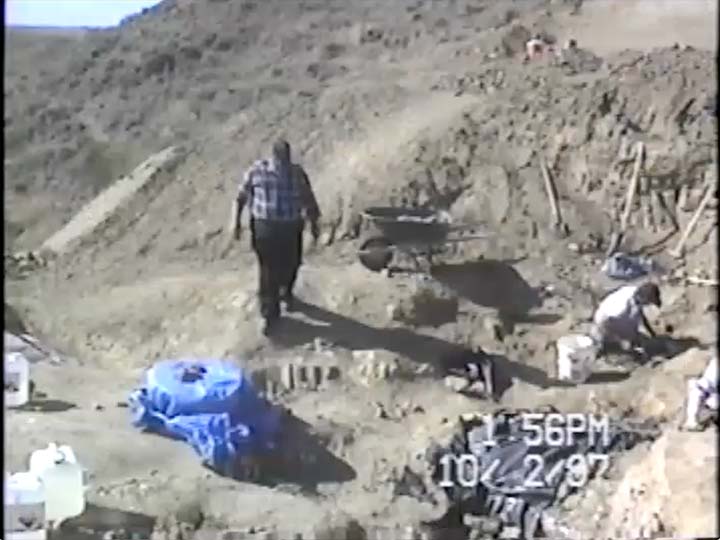
“The sale of ‘Sue’ caused my problems. The two cases are inextricably linked,” Rigby told Science News in December 1997.
With knowledge of the going rate for a T. rex, the Waltons contacted Nate Murphy, an amateur paleontologist who lived nearby, asking him in early September to help them unearth Rigby’s rex. In the March 1998 issue of the magazine Smithsonian, Fred Walton reportedly said to Murphy: “Well, Nate, if we don’t get one of you guys to come along, we’re going to go up there by ourselves and rip that SOB out of the hill.”
According to the Smithsonian account, Murphy was leery of working on someone else’s dig, but eventually thought it best to help the Waltons in order to ensure they didn’t damage the T. rex bones. However, after becoming more and more suspicious of their claim to the land and their motives, Murphy soon left the scene — but, according to Smithsonian, did not inform law enforcement of what the Waltons were up to. “I still thought it was all a matter of feuding within the Walton family,” Murphy told the magazine’s reporter.
That’s when Glasgow, Montana, attorney Jim Rector came to the rescue.
“Keith came out here every year for many years, and even spoke to our Kiwanis Club,” Rector recalled in a phone conversation. A good friend of Rigby’s, Rector was one of the few people other than the participants in the dig who knew just what had been discovered — and where — that summer.
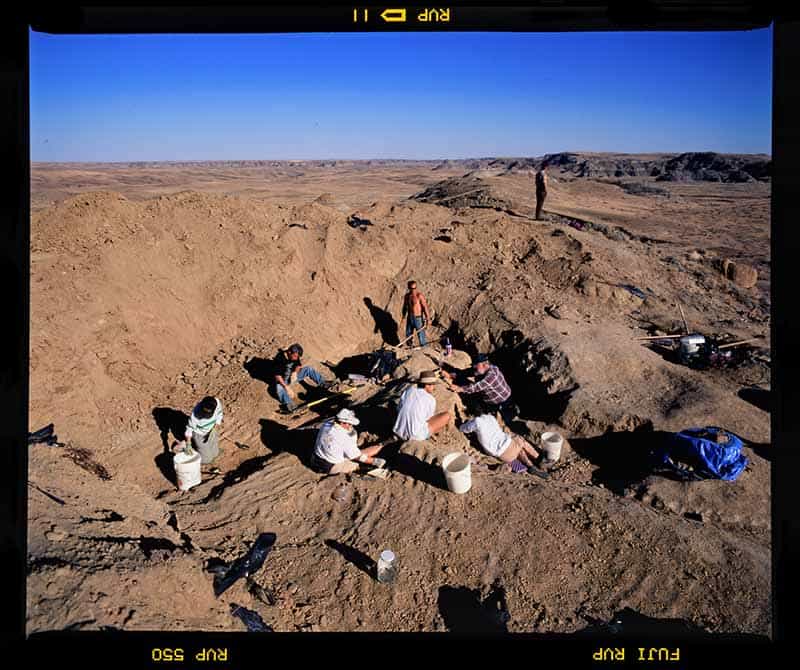
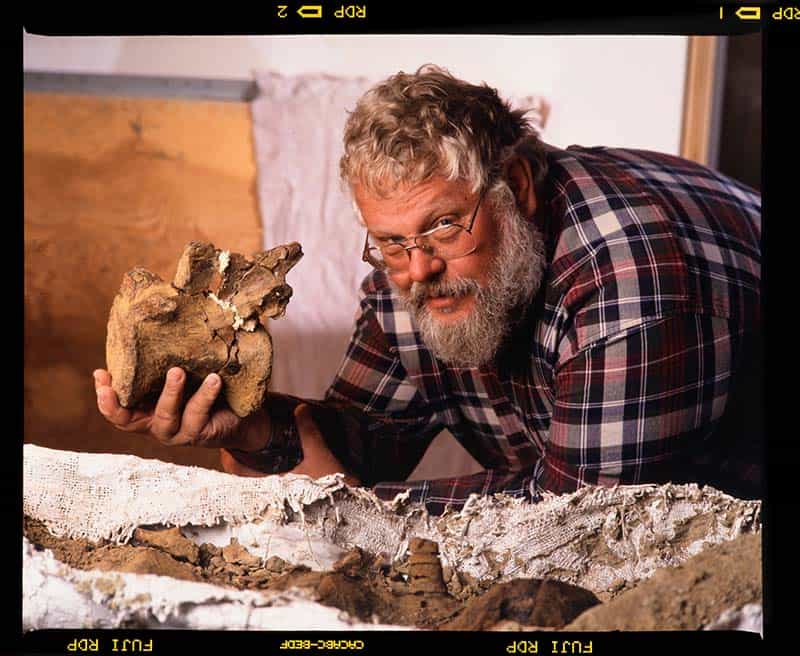
On Sept. 13, Rector and his friend Skip Erickson went fishing and, on the way home, stopped to get a beer at The Gateway bar (“Best damn bar by a dam site”). “A young lady we both knew told us all about how she had seen the dinosaur bones,” Rector said. “That seemed unusual. I called Keith to let him know what was going on, and he asked us to keep an eye on things.
“I went up (to the site) the next day and Skip and I watched them (the Waltons) digging with a backhoe. They saw us and asked what we were doing, and I said, ‘What are you doing.’ They said that this was their land and it was their dinosaur. They had guns and were displaying them and they made veiled and not-so-veiled threats.”
Rector told the reporter from Smithsonian that one of the Waltons said: “I’m gonna save my land and feed my family.” Smithsonian also reported that local residents feared the situation could escalate into something akin to the Montana Freemen and Ruby Ridge standoffs; the former, about 90 miles south of Fort Peck, ended without fatalities, but the latter led to the deaths of three people, including a U.S. marshal, in Idaho.
After Rector informed Rigby of the poachers at his dig site, the professor called the FBI. An agent and the McCone County deputy sheriff arrived not long after Rector confronted the Waltons and ordered the ranchers to vacate the premises, which they did, but not before damage had been done.
The confrontation on Sept. 14 between the Waltons and law enforcement garnered widespread media attention, and headline writers had a field day:
- Fossil Feud
- Bone of Contention
- No Bones About It
- A Bone to Pick
- Finder, Farmer Fight over Fossil
- Prehistoric Poaching
The national media accounts helped Rigby as he assembled a team to make an emergency trip to Montana to assess the situation. On Sept. 26, Rigby, joined by Notre Dame students and others who had worked with him through the years, including Lou Tremblay, arrived in Fort Peck to ascertain just what the Waltons had done to the massive fossilized dinosaur skeleton that had been found two-and-a-half months earlier.
After carefully uncovering the site, Rigby found that two-thirds of the left side of the T. rex skull was missing, as were both of the lower jaws. “This is about as bad as I could have imagined,” he said in a news release issued that day by Notre Dame. “We had a virtually complete skull, and now I’m wondering what I can do to repair the damage.”
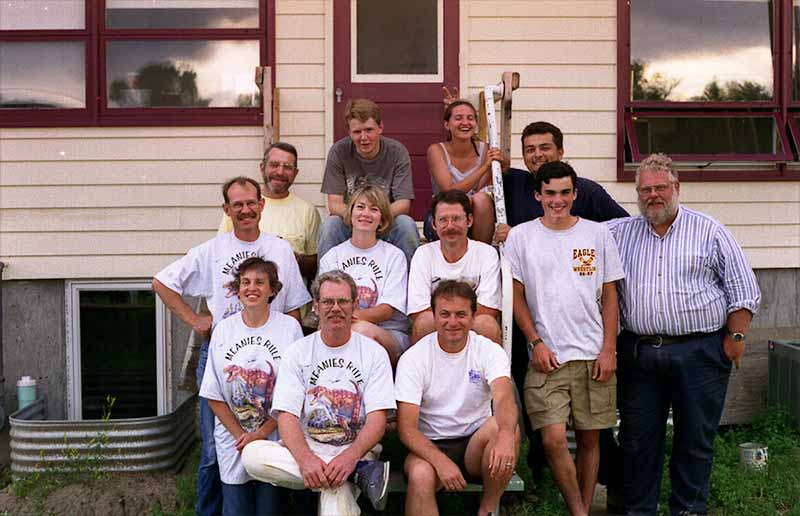
Fortunately, and unbeknownst to Rigby at the moment, the FBI in Great Falls, Montana, had taken possession of the jaws, which had been turned in by two unidentified people, according to local media reports. With knowledge that the damage wasn’t as bad as originally feared, the team began an emergency excavation. They were able to do so with the permission of the Department of Agriculture, which owned the land after the Waltons foreclosed on the property. The bones were moved to a large facility that had served as a laundry for workers on the Fort Peck Dam in the 1930s.
With the help of Tremblay, Notre Dame students, other volunteers and regional experts, Rigby was able over the next couple of years to make repairs and cast and prepare the specimen for display. Funds were tight, but the Maryland Science Center stepped in to help finance the project with the proviso that it would receive a specimen for display. Tremblay attended the grand opening of the exhibit in Baltimore in 2007.
It was Rigby’s desire after the discovery to have the cast of a fully mounted skeleton on display in Fort Peck. It took some time, but the Fort Peck Interpretive Center and Museum opened in 2005 under the auspices of the Corps of Engineers and is the home of a cast of Peck’s Rex and a 14-foot-tall fleshed-out model, as well as other fossils and exhibits of the region. The center is one of 14 sites on the Montana Dinosaur Trail.
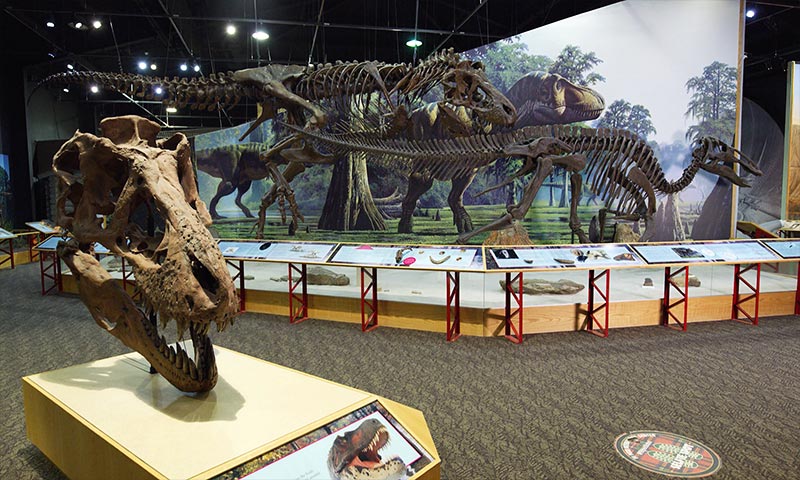
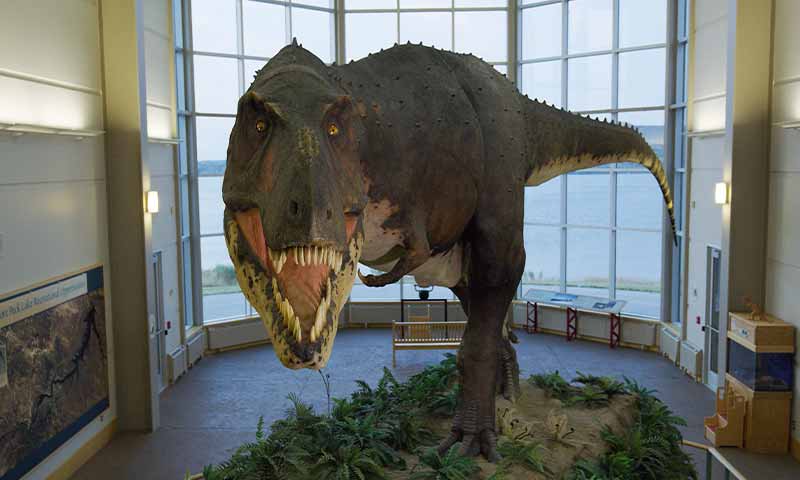
Another cast is in the Carnegie Museum of Natural History in Pittsburgh, where it is displayed in a “face-off” with another T. rex specimen.
The original bones that were unearthed by Rigby’s team are mounted and exhibited at the Museum of the Rockies in Bozeman, Montana. A T. rex that was found in 1988 not far from Peck’s Rex was on display in Bozeman for 20 years. It is now called Nation’s Rex and is a centerpiece of the Smithsonian’s National Museum of Natural History in Washington, D.C.
A cast of the skull is the highlight of the J. Keith Rigby Jr. Fossil Collection in the Museum of Biodiversity on the first floor of Notre Dame’s Jordan Hall of Science.
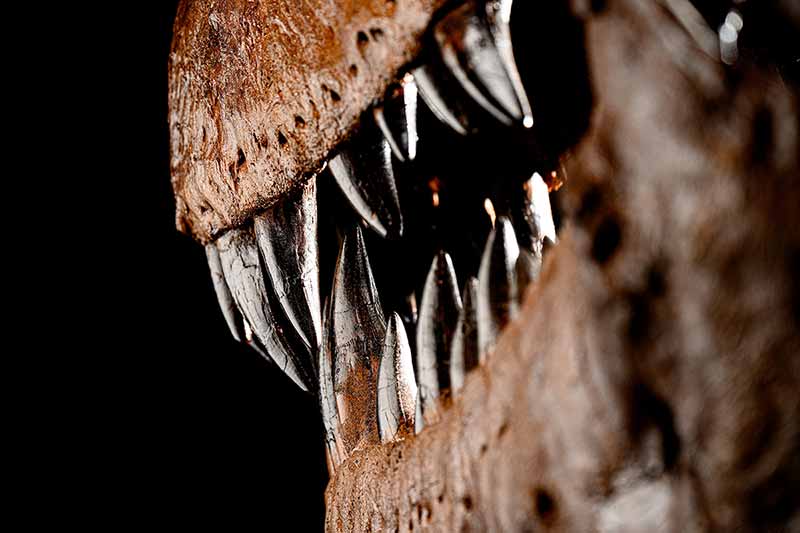
The assembled original bones of Peck’s Rex at the Museum of the Rockies (where it’s known as Montana’s Rex) stand 12 feet tall and 38 feet long. The dinosaur would have weighed approximately 7 tons. It is the only T. rex skeleton to have been found with both humerus (arm) bones and a third metacarpal (finger) bone.
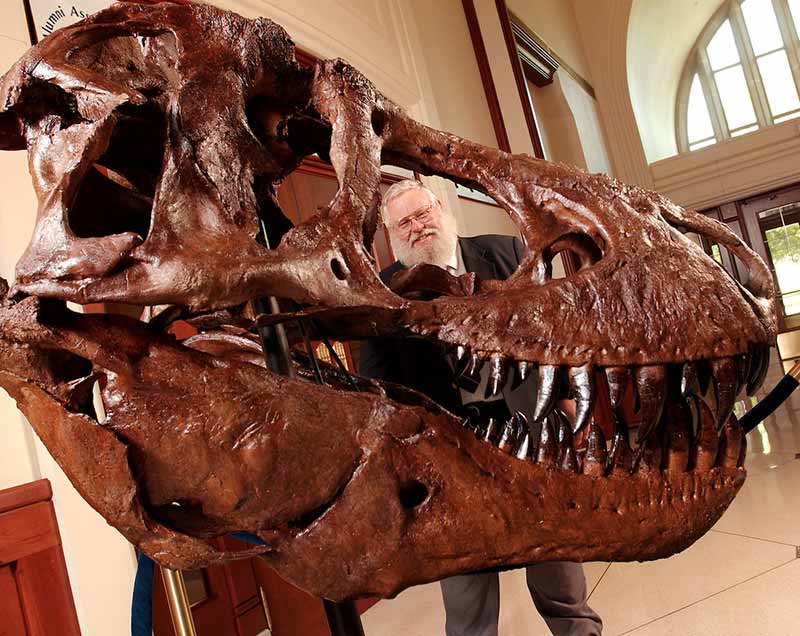
A barrel of a man with a full, white beard, Rigby was also quick with a quip, making him a favorite of science reporters throughout his career.
On his research disputing the asteroid theory, he told Science News: “The asteroid was the icing on a cake that had already been baked.” In another media account he said most dinosaurs already had “one foot in the grave and the other on a banana peel” when the asteroid struck.
After the discovery of Peck’s Rex, Rigby wasn’t absolutely sure it was a “tyrant lizard king” specimen. He told an Associated Press reporter: “There is some possibility that it may be new, and T. rex may have to become T. who?”
In an interview with Notre Dame Magazine, Rigby discussed the evidence of bite marks, wounds, cysts, arthritis and cancer found in various T. rex specimens. “T. rex is supposed to be the top dog of the dinosaur world, ‘Mr. and Mrs. Tough.’ That’s the popular imagine. But it might not have been the case. T. rex did not have a white-collar lifestyle. It lived in a tough neighborhood and survived by tooth and claw.”
Rigby died Nov. 5, 2011. He was 64.
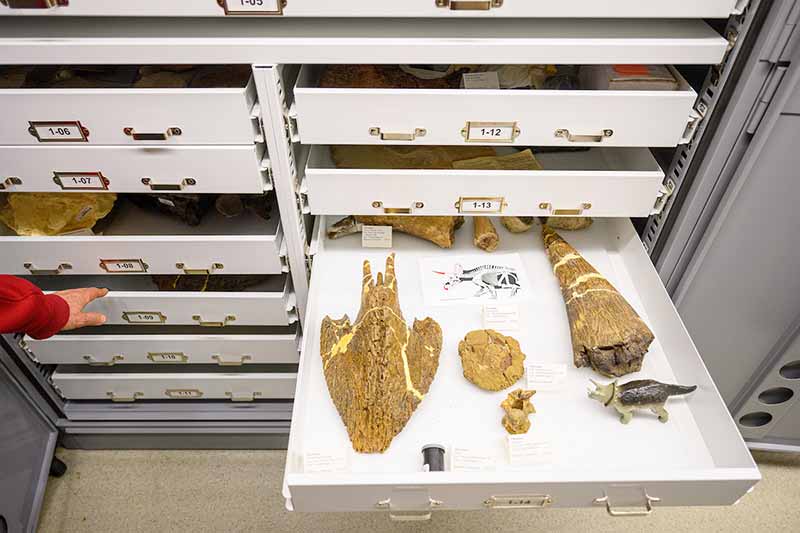
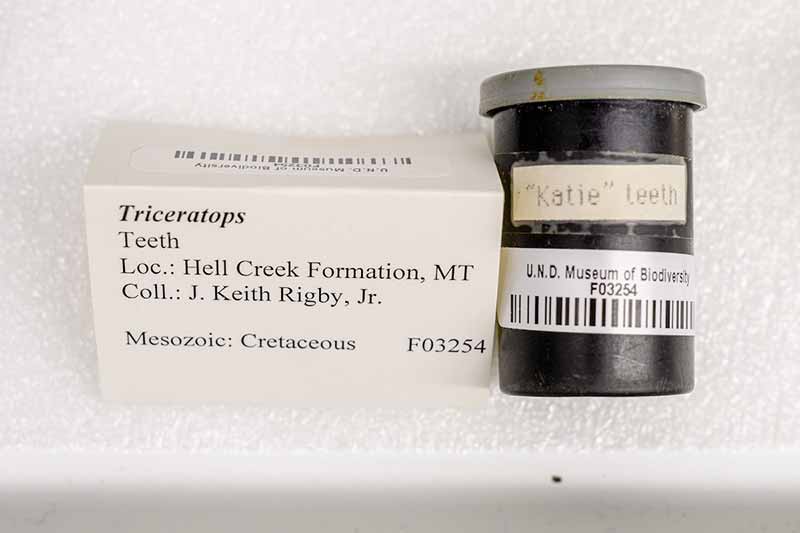
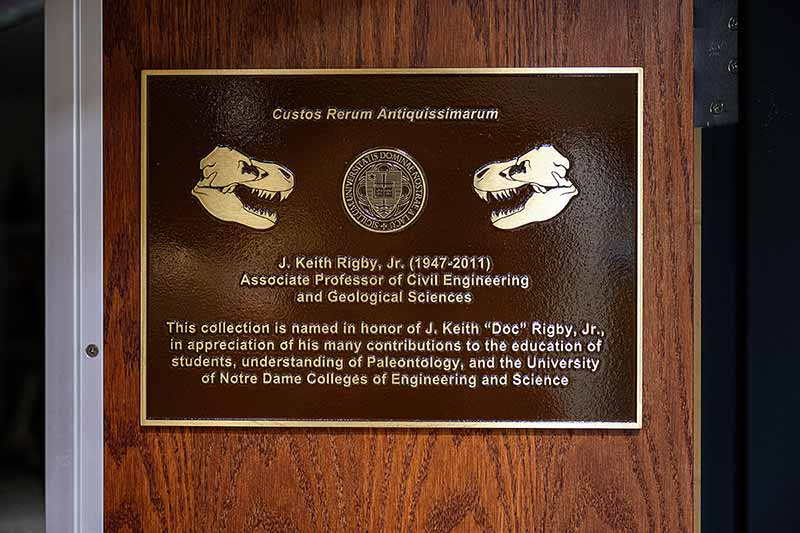
Among others involved in the saga of Peck’s Rex:
Now 80, Lou Tremblay splits his retirement time between Connecticut and Florida. Finding the first bones of Peck’s Rex “was definitely a life-changing event for me,” Tremblay said. “That’s when my world changed because there were newspaper reporters, TV cameras. For me, a lot of the excitement came following all of that, because I was able to meet some of the biggest names in the field of paleontology, and I’ve been able to participate in dinosaur digs around the world. This whole involvement with Dr. Rigby impacted many lives in many ways.” Tremblay’s car has a customized T-REX license plate, and more photos of his various adventures are on his website, dinolou.com.
Jim Rector, the attorney and a friend of Rigby whose quick thinking and actions saved further damage to the fossils, is now retired and continues to live in Glasgow. On his role in stopping the Waltons, he said: “It was pure happenstance. We just stopped to get a beer.”
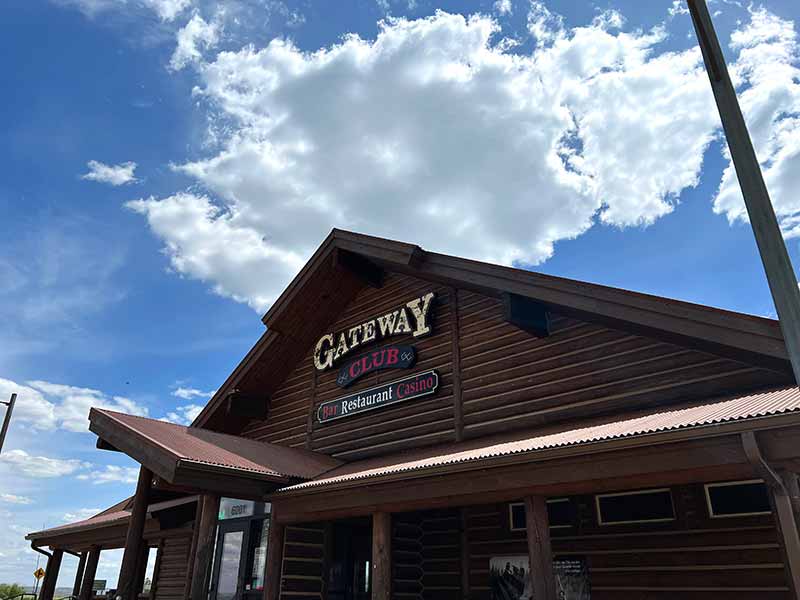
The Gateway Club, where Rector and Erickson stopped for that beer, burned to the ground a few years ago but has been rebuilt on the same site overlooking Fort Peck Lake.
After phone and email inquiries to several prosecutors’ offices in Montana, it seems no charges were filed against the Waltons.
The T. rex skeleton known as Sue sold at auction in October 1997, not for $1 million, but $8.36 million. She is now on permanent display at Chicago’s Field Museum of Natural History.
And then there is Nate Murphy, the amateur paleontologist who left the scene after becoming suspicious of the Waltons. According to multiple media accounts, he was ordered to pay $17,325 in restitution, sentenced to three years of probation and received 120 days in a pre-release center after pleading guilty — to stealing a separate set of dinosaur bones from federal land in 2007.
Special thanks to Sue Dalbey, U.S. Army Corps of Engineers and director of the Fort Peck Interpretive Center and Museum; Lou Tremblay; Jim Rector; Mike Hagfeldt; Ted Wood Photography; and Sherry Wright, assistant in the Valley County Attorney’s Office.
